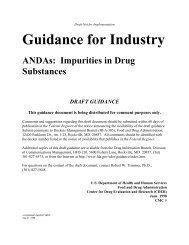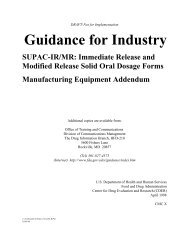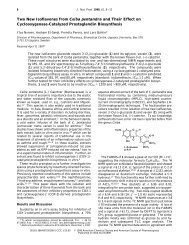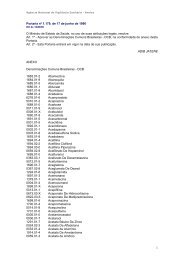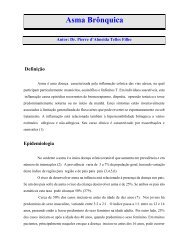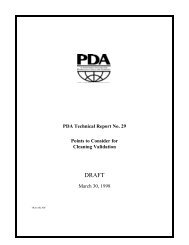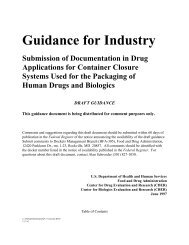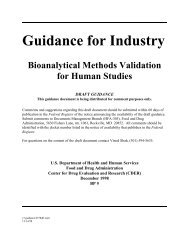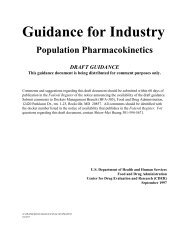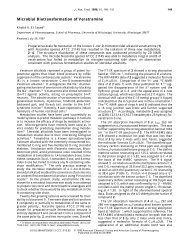Pharmaceutical Blister Packaging, Part I - Pharmanet
Pharmaceutical Blister Packaging, Part I - Pharmanet
Pharmaceutical Blister Packaging, Part I - Pharmanet
You also want an ePaper? Increase the reach of your titles
YUMPU automatically turns print PDFs into web optimized ePapers that Google loves.
<strong>Pharmaceutical</strong><br />
<strong>Blister</strong> <strong>Packaging</strong>, <strong>Part</strong> I<br />
Rationale and Materials<br />
Ron Pilchik<br />
Eighty-five percent of<br />
solid drugs in Europe are<br />
packed in blisters,<br />
compared with less than<br />
20% of those in the<br />
United States. However,<br />
blister packaging is<br />
becoming more accepted<br />
in the United States as<br />
both manufacturers and<br />
consumers recognize its<br />
benefits. This article<br />
discusses the materials<br />
used for blister packages<br />
and typical blister<br />
constructions.<br />
Ron Pilchik is a principal at<br />
The Techmark Group, 1040<br />
North Kings Highway, Suite 707,<br />
Cherry Hill, NJ 08034-1921,<br />
tel. 609.482.8871, fax 609.482.<br />
9263, e-mail ronp@netreach.<br />
net,www.techmarkgroup.com.<br />
P<br />
ackaging is one of the largest industry<br />
sectors in the world, worth<br />
$280 billion. Consumer healthcare<br />
packaging represents 4% ($11.2 billion)<br />
of the packaging industry. As drug<br />
manufacturers approach the 21st century,<br />
they face a number of challenges that<br />
packaging can help them meet.<br />
A decade ago packaging often was an<br />
afterthought for many pharmaceutical<br />
companies, viewed as merely the final step<br />
in manufacturing. But now firms must<br />
consider packaging earlier during the development<br />
process. <strong>Pharmaceutical</strong> packaging<br />
is quickly becoming an essential<br />
part of the drug delivery system as well<br />
as a core element of the marketing mix,<br />
through which manufacturers can differentiate<br />
their products from those of<br />
their competitors. The demand for pharmaceutical<br />
packaging is increasing and<br />
will continue to increase as companies<br />
rely more on packaging and labeling as<br />
media to protect and promote their products,<br />
increase patient compliance, and<br />
meet new regulations.<br />
Basic configuration of<br />
blister packaging<br />
Background. Two basic types of pharmaceutical<br />
blister packages exist. In one variety<br />
the cavity is constructed of clear,<br />
thermoformed plastic, and the lid is<br />
formed of clear plastic or a combination<br />
of plastic, paper, and/or foil. The other<br />
type of package contains foil as an essential<br />
component of both webs, and its<br />
cavity is created by cold stretching. Figure<br />
1 shows the basic configuration of a<br />
blister pack.<br />
In the early 1960s, Karl Klein designed<br />
the first machinery for producing pushthrough<br />
blister packaging. He did not obtain<br />
a patent for the design because the<br />
European pharmaceutical industry was<br />
not very interested in it — that is, until<br />
68 <strong>Pharmaceutical</strong> Technology NOVEMBER 2000 www.pharmaportal.com<br />
PHOTODISC, INC.
the birth control pill was formulated a few<br />
years later. For this revolutionary product<br />
Schering (Berlin, Germany) chose blister<br />
packaging because it seemed to be the<br />
most appropriate way to package the pill<br />
for effective administration.<br />
Thus the most important reason for<br />
introducing blister packaging technology<br />
was to offer patients a clearly marked individual<br />
dose, enabling them to check<br />
whether they had taken the prescribed<br />
drugs on a given day. Moreover, the drugs<br />
that were not taken remained in the original<br />
package and were fully protected<br />
against adverse external conditions. The<br />
patient could handle the blister package<br />
more easily and could store it more conveniently<br />
than conventional packages.<br />
Very soon, manufacturers and packagers<br />
recognized other advantages of blister<br />
packaging such as the prevention of<br />
broken glass bottles and reduced costs and<br />
higher packaging speeds relative to other<br />
packaging materials. Another important<br />
benefit became apparent later: It is easier<br />
to prove misuse with blister packaging<br />
than with conventional packaging. Thus,<br />
blister packages effectively meet the demand<br />
for tamper-evident packaging. All<br />
these advantages explain why blister packaging<br />
is used for approximately 85% of<br />
solid drugs in Europe.<br />
Use in Europe versus use in the United<br />
States. The situation is just the opposite<br />
in the United States, where virtually all<br />
over-the-counter and prescription drugs<br />
are packaged in bottles. For example, less<br />
than 20% of nonliquid pharmaceutical<br />
products in the United States currently are<br />
sold in blister packs.<br />
There has been a great deal of speculation<br />
about the causes for the difference in<br />
the use of blister packaging in the United<br />
States and Europe. First, following World<br />
War II, European packaging machinery<br />
(like almost everything else) lay in ruins.<br />
Drug packagers in Europe started over<br />
from scratch, and when they did they<br />
chose blister machinery over bottle equipment.<br />
Second, European regulations on<br />
child-resistant closures are far less stringent<br />
than rules in the United States.<br />
A third reason lies in the differences<br />
among health plans in the two areas. In<br />
Europe, most health plans limit the number<br />
of units that can be prescribed at one<br />
time to a 10- to 14-day supply. In the<br />
United States, however, insurers allow a<br />
longer supply period, typically 30 to 60<br />
days. The smaller European purchase<br />
quantity favors blister packaging because<br />
it costs less to package small numbers of<br />
items in blisters than in bottles. Finally,<br />
the European community has stronger<br />
environmental incentives to use blister<br />
packaging. For example, manufacturers<br />
are penalized for introducing excessive<br />
material into the system. The use of blister<br />
packaging allows manufacturers to reduce<br />
packages to a minimal size.<br />
Increased use in the United States. <strong>Blister</strong><br />
packaging is becoming more accepted in<br />
the United States as pharmaceutical manufacturers<br />
and consumers recognize its<br />
benefits. <strong>Blister</strong> packs can help patients<br />
follow drug regimens, protect drugs over<br />
a long shelf life, and are portable. Advocates<br />
of blister packaging in the United<br />
States cite five aspects in which blister<br />
packaging is better than conventional<br />
packaging.<br />
● product integrity<br />
● product protection<br />
● tamper evidence<br />
● reduced possibility of accidental misuse<br />
● patient compliance.<br />
Product integrity. The retail-level preparation<br />
of prescription drugs in the United<br />
States is troubling. Pharmacists or pharmaceutical<br />
technicians count pills in the<br />
uncontrolled atmosphere of the supermarket<br />
and drug store, where many factors<br />
can negatively affect sensitive drugs<br />
as they are transferred from container to<br />
container.<br />
<strong>Blister</strong> packaging helps retain product<br />
integrity because drugs that are prepackaged<br />
in blisters are shielded from<br />
adverse conditions. Furthermore, opportunities<br />
for product contamination are<br />
minimal, and each dose is identified by<br />
product name, lot number, and expiration<br />
date. Therefore, blister packaging<br />
ensures product integrity from the producer<br />
directly through distribution to the<br />
consumer.<br />
Product protection. <strong>Blister</strong> packaging protects<br />
pharmaceuticals in the home better<br />
than bottles do. For example, most consumers<br />
store their medicines within the<br />
medicine cabinet in the bathroom. But the<br />
bathroom environment periodically is<br />
filled with clouds of steam. As a result, it<br />
may be no exaggeration to say that once<br />
Plastic blister<br />
Product<br />
an opened bottle of pills has been stored<br />
under these conditions, the unused pills<br />
will never be the same.<br />
<strong>Blister</strong> packaging, however, keeps each<br />
tablet or capsule hermetically sealed in<br />
its own bubble. Drugs that are not taken<br />
remain in the original package and are<br />
fully protected against external conditions.<br />
A blister protects a moisturesensitive<br />
tablet right up to administration.<br />
In contrast, the moisture in the<br />
headspace of a multiple-unit bottle is replaced<br />
each time the bottle is opened.<br />
Tamper evidence. Tamper evidence is another<br />
strength of blister packaging. The<br />
dosage units are individually sealed in<br />
constructions of plastic, foil, and/or<br />
paper. The package must be designed so<br />
that one must tear the compartment to<br />
get at the product, and it must not be<br />
possible to separate the backing materials<br />
from the blister without leaving evidence.<br />
Once a bottle has been opened,<br />
whatever tamper-evident mechanism it<br />
had is gone. With blister packaging, however,<br />
each tablet or capsule is individually<br />
protected from tampering until use,<br />
so any form of tampering with a blister<br />
package is immediately visible.<br />
Possibility of accidental misuse. <strong>Blister</strong> packaging<br />
also can be made child resistant,<br />
and several such designs currently are in<br />
use. Most child-resistant blister packages<br />
contain a paper/film layer with a peelable<br />
adhesive. Patients must peel the adhesive<br />
away from the foil backing before the pill<br />
can be pushed through. Specifying 15-mil<br />
polyvinyl chloride (PVC) blister stock<br />
provides extra security because it is less<br />
likely that children could puncture the<br />
package by biting through it. Companies<br />
also are experimenting with bitter coatings<br />
to deter children from putting packages<br />
in their mouths.<br />
Patient compliance. Finally, an additional<br />
70 <strong>Pharmaceutical</strong> Technology NOVEMBER 2000 www.pharmaportal.com<br />
Lid<br />
Figure 1: The basic configuration of blister<br />
packaging.
Lidding<br />
Forming film<br />
Figure 2: Basic components of blister packaging.<br />
Table I: Comparison of forming films.<br />
Type and Thickness WVTR Price per<br />
of Forming Film (mil) (g/m 2 /day)* Unit Area**<br />
PVC (10) 1.1 1<br />
PVC/PVDC (10/1.2) 0.17 2.1<br />
PVC/CTFE (8/0.76) 0.07 2.1<br />
PP (12) 0.20 1.3<br />
PET (10) 2.6 1.4<br />
PS (12) 6 1.2<br />
OPA/aluminum/PVC (1/1.8/2.4) 0 2.9<br />
*As measured on the unformed film at an ambient temperature of 20 �C and 85% RH.<br />
**Where 1 represents the price per unit area of 10-mil PVC.<br />
benefit is the role of blister packaging in<br />
compliance. As many as 30% of all prescriptions<br />
are not taken properly initially,<br />
and as many as 50% are not continued<br />
after one year. Such misuse can cause a<br />
range of adverse drug reactions, including<br />
death.<br />
The Healthcare Compliance <strong>Packaging</strong><br />
Council (HCPC, Washington, DC) was<br />
formed in 1990 as a nonprofit corporation<br />
to educate consumers, professionals,<br />
and policymakers in the healthcare field<br />
about the role of blister packaging in<br />
pharmaceutical compliance. Following are<br />
some of the relevant data that HCPC has<br />
uncovered in recent studies in the United<br />
States:<br />
● A total of 1.8 billion prescriptions are<br />
given each year, and half are taken incorrectly.<br />
● Ten percent of all hospital admissions result<br />
from pharmaceutical noncompliance.<br />
Lidding material<br />
Inks<br />
Forming film<br />
Print primer<br />
Basic material<br />
Sealing agent<br />
Coating<br />
Basic material<br />
● The cost of such noncompliance is estimated<br />
at $13–15 billion annually.<br />
● Twenty-three percent of the people admitted<br />
to nursing homes are aged and<br />
cannot manage their medications in<br />
their own homes.<br />
● An estimated 125,000 people in the<br />
United States die each year because they<br />
do not take medications as prescribed.<br />
● The elderly population, which consumes<br />
roughly 50% of all prescription drugs,<br />
is growing, making abuse problems even<br />
more critical.<br />
Furthermore, blister packs can be bar<br />
coded for use in hospitals and nursing<br />
homes to prevent errors in distributing<br />
medication. One final important benefit<br />
of blister packaging in patient compliance<br />
is that pharmacists have a greater opportunity<br />
to communicate with and advise<br />
their patients because less time is necessary<br />
to fill the prescription.<br />
The use of blister packaging in the<br />
United States is on the rise. For example,<br />
several years ago the states of New York<br />
and New Jersey adopted regulations requiring<br />
hospitals to implement unit-dose<br />
blister-packaging distribution systems.<br />
The New Jersey Society of Hospital<br />
Pharmacists cited reports showing that<br />
fewer medication errors occur in such<br />
unit-dose blister package systems. Logic<br />
would seem to dictate that more states<br />
will adopt similar regulations.<br />
<strong>Blister</strong> packaging components<br />
The four basic components of pharmaceutical<br />
blister packages are the forming<br />
film, the lidding material, the heat-seal<br />
coating, and the printing ink (see Figure<br />
2). The most common blister package in<br />
the United States is made of a foil, film,<br />
paper, or multimaterial backing that is<br />
adhered to a sheet of thermoformed plastic<br />
bubbles. Forming films account for approximately<br />
80–85% of the blister package,<br />
and lidding materials make up<br />
15–20% of the total weight of the package.<br />
Because the forming film and the lidding<br />
material form an integrated package,<br />
they must match precisely.<br />
Forming film<br />
The forming film is the packaging component<br />
that receives the product in deepdrawn<br />
pockets. One key to package success<br />
is selecting the right plastic film for<br />
the blisters in terms of its property type,<br />
grade, and thickness. Consideration must<br />
be given to the height and weight of the<br />
product, sharp or pointed edges of the<br />
final package, and the impact resistance,<br />
aging, migration, and cost of the film.<br />
The plastic also must be compatible with<br />
the product. Factors influencing package<br />
production and speed of assembly must<br />
be taken into account, including heatsealing<br />
properties and the ease of cutting<br />
and trimming formed blisters.<br />
Characteristics. Plastic forming films<br />
such as PVC, polypropylene (PP), and<br />
polyester (PET) can be thermoformed,<br />
but support materials containing aluminum<br />
are cold-formed. The forming<br />
film usually is colorless and transparent,<br />
but it can be obscured for use in childresistant<br />
packages or to protect lightsensitive<br />
drugs. The forming web for blister<br />
packs nearly always is PVC, sometimes<br />
72 <strong>Pharmaceutical</strong> Technology NOVEMBER 2000 www.pharmaportal.com
coated or laminated with additional components<br />
that enhance the oxygen and<br />
water-vapor barrier. Table I compares the<br />
water-vapor transmission rate (WVTR)<br />
and the price per unit area of various<br />
forming films.<br />
Types of forming films. PVC forming film<br />
is called rigid PVC because it is almost free<br />
of softening agents. Rigid PVC is a very<br />
clear, stiff material with a low WVTR. It<br />
exhibits excellent thermoformability; a<br />
high flexural strength; good chemical resistance;<br />
low permeability to oils, fats, and<br />
flavoring ingredients; easy tintability; and<br />
low cost. These properties make rigid PVC<br />
the material of choice for blister packaging,<br />
and it essentially has 100% of the market<br />
for the plastic component. PVC films<br />
that are thermoformed have a thickness<br />
of about 10 mil.<br />
The use of PVC has attracted much<br />
criticism because its combustion produces<br />
hydrochloride emissions and, under unfavorable<br />
conditions, highly toxic dioxins.<br />
Legislation in Germany and Switzerland<br />
prohibits the incineration of PVC, the<br />
principal method of disposal used in those<br />
countries. This has created a bias toward<br />
the use of PP for blister packaging in Europe,<br />
where many pharmaceutical companies<br />
now stipulate that any new blister<br />
machines must be capable of handling<br />
both PVC and PP.<br />
Polyvinylidene chloride (PVDC)–coated PVC. Although<br />
its volume in drug packaging is<br />
small, PVDC plays a critical role in blister<br />
packaging as laminations or coatings<br />
on PVC. PVDC is the most common coating<br />
in blister packaging because it can reduce<br />
the gas and moisture permeability<br />
of PVC blister packages by a factor of<br />
5–10. Coated PVC films have a thickness<br />
of 8–10 mil; the thickness of the PVDC<br />
coat amounts to 1–2 mil. The coating is<br />
applied on one side and usually faces the<br />
product and the lidding material.<br />
PVC/chlorotrifluoroethylene (CTFE). Films made<br />
from PVC and CTFE have the lowest<br />
water-vapor permeability of all films used<br />
for blister packaging. When compared with<br />
the water-vapor permeability of 10-mil<br />
PVC, the permeability of 8-mil PVC/0.76mil<br />
CTFE is lower by a factor of 15. However,<br />
the environmental concerns regarding<br />
PVC also apply to PVC/CTFE films.<br />
PP. There is an increasing trend toward<br />
using PP as a support material for blister<br />
packages. The water-vapor permeability<br />
of uncoated PP is lower than that of PVC<br />
and is comparable to that of PVDC-coated<br />
PVC. The thickness of PP films used in the<br />
thermoforming process ranges from 10 to<br />
12 mil.<br />
Advantages of PP include easy recyclability,<br />
no release of toxins during incineration,<br />
and good moisture-barrier properties.<br />
PP is a possible replacement for PVC,<br />
especially in Europe.<br />
However, the use of PP has its drawbacks.<br />
One problem is thermoforming.<br />
The temperatures required for thermoforming<br />
PP and for the subsequent cooling<br />
process must be controlled precisely.<br />
Warping also can occur, in which case the<br />
packages must be straightened before cartoning.<br />
Other difficulties associated with<br />
the use of PP include its thermal instability,<br />
higher rigidity than PVC, and susceptibility<br />
to postprocessing shrinkage.<br />
In addition, PP is difficult to run on a<br />
standard blister machine and cannot be<br />
processed as fast as PVC. If a company<br />
runs PP and needs new equipment, it<br />
must go through a precise validation<br />
process, performing various tests on PP<br />
to satisfy FDA requirements. As a result,<br />
PP is virtually nonexistent in pharmaceutical<br />
blister packaging in the United<br />
States, and it still appears to be used minimally<br />
for that purpose in Europe.<br />
PET is another material that may replace<br />
PVC, but its relatively high water-vapor<br />
permeability compared with that of PVC<br />
will prevent its universal use. PVDCcoated<br />
PET could have the same watervapor<br />
barrier effect as PVC, but this does<br />
not appear to be promising in view of the<br />
larger goal to replace chlorous plastics with<br />
PET.<br />
Paper (45–50 g/m 2 )<br />
Adhesive<br />
PET (12 �m)<br />
Adhesive<br />
Heat-seal coating (6–9 g/m 2 )<br />
Polystyrene (PS) is perfectly compatible<br />
with thermoforming, but its high watervapor<br />
permeability makes it unsuitable<br />
as a blister material for pharmaceutical<br />
purposes.<br />
Oriented polyamide (OPA)/aluminum/PVC or<br />
nylon/aluminum/PVC. OPA/aluminum/PVC<br />
laminates are intriguing. With a laminate<br />
structure consisting of 1-mil OPA, 1.8mil<br />
aluminum, and 2.4-mil PVC it is possible<br />
to eliminate water-vapor permeability<br />
almost entirely. Moreover, because<br />
of the large proportion of aluminum in<br />
the laminate, recycling this material has<br />
become feasible (particularly because<br />
most lidding materials also contain aluminum).<br />
Enormous efforts are being<br />
made to replace PVC with PP in such<br />
laminates to comply with environmental<br />
standards.<br />
Like other laminates containing aluminum,<br />
the OPA/aluminum/PVC laminate<br />
is cold-formed. Its cost per square<br />
meter can stand any critical comparison<br />
with PVDC-coated PVC. Cold-forming,<br />
however, requires more packaging material<br />
than does thermoforming to package<br />
the same number of the same size of<br />
tablets or capsules.<br />
CTFE homopolymer. Honeywell (Morristown,<br />
NJ) recently introduced a 3-mil<br />
CTFE homopolymer barrier film (Aclar<br />
UltRx 3000) that can be thermoformed<br />
easily and that exhibits the highest moisture<br />
barrier of clear films. This reflects the<br />
trend toward the use of higher-barrier<br />
materials. Various Aclar products have allowed<br />
wider use of blister packaging because<br />
they can be thermoformed into<br />
clear or tinted blister cavities and exhibit<br />
barrier properties close to those of the<br />
near-perfect barrier offered by foil.<br />
74 <strong>Pharmaceutical</strong> Technology NOVEMBER 2000 www.pharmaportal.com<br />
Inks<br />
Figure 3: Cross section of a peel off–push through lidding material.<br />
Foil (15–25 �m)
Table II: Comparison of lidding materials.<br />
Price per Unit Area<br />
Lidding Material (g/m 2 ) Weight*<br />
0.8-mil Aluminum, hard, push-through 60 1<br />
0.8-mil Aluminum, hard, heat seal–coated,<br />
side-printed, push-through 61 1.25<br />
1-mil Aluminum, soft, child resistant 76 1.15<br />
45 g(m �2 )/1-mil Paper/aluminum, peel-off 121 1.55<br />
45 g(m �2 )/0.48-mil Paper/PET/aluminum,<br />
peel off–push through 142 2.00<br />
*Where 1 represents the price per unit area of 0.8-mil, hard, push-through aluminum.<br />
Lidding materials<br />
The lidding material provides the base or<br />
main structural component upon which<br />
the final blister package is built. It must<br />
be selected according to the size, shape,<br />
and weight of the product as well as the<br />
style of the package to be produced. Lidding<br />
materials range in caliper or thickness<br />
from 0.36 to 0.76 mm, but 0.46–0.61<br />
mm is the most popular range. The surface<br />
of the lidding material must be compatible<br />
with the heat-seal coating process.<br />
Clay coatings are added to the lidding material<br />
to enhance printing. Heat-sealing<br />
and printability are both important considerations<br />
in blister packaging, and the<br />
lidding material must offer the best workable<br />
compromise.<br />
Characteristics. The lidding material can<br />
be clear plastic, but in pharmaceutical<br />
packaging it is either plain or printed 1mil<br />
foil (for push-through blister types)<br />
or paper/foil or paper/PET/foil laminations<br />
(for child-resistant peel–push types).<br />
The lidding material must guarantee a<br />
WVTR that is at least as low as that of the<br />
forming films, and it must be suitable for<br />
the type of opening appropriate to the<br />
package (e.g., push-through or peel-off).<br />
Figure 3 shows a cross-section of a peel<br />
off–push through lidding material. Table<br />
II shows the comparative cost per unit<br />
area of various lidding materials.<br />
Types of lidding materials. Hard aluminum is<br />
the most widely used push-through lidding<br />
material in Europe. The foil usually has a<br />
thickness of 0.8 mil. There are endeavors,<br />
however, to reduce the thickness of this foil<br />
to 0.6 mil. The hardness of the aluminum<br />
facilitates push-through opening.<br />
Usually, only the print primer side features<br />
a printed design, but occasionally the<br />
side with the heat-sealing coating also can<br />
be printed. A double coat of heat-sealing<br />
coating (a heat-sealing primer and the actual<br />
heat-sealing coating) has become the<br />
standard for lidding materials.<br />
The heat-sealing primer ensures optimum<br />
adhesion of the heat-sealing coating<br />
to the aluminum foil. The heat-sealing<br />
coating can then be matched to the formed<br />
films. If the heat-sealing primers are colored,<br />
applying the heat-sealing coating over<br />
the primer can protect the packaged product<br />
from coming in contact with the pigments.<br />
If additional printing is required<br />
on the side of the heat-sealing coating, the<br />
only alternative is to apply two coats of the<br />
coating. This technique is necessary because<br />
the printing inks must be located between<br />
the heat-sealing primer and the actual<br />
heat-sealing coating.<br />
Soft aluminum (1 mil) frequently is used<br />
for child-resistant push-through foils. With<br />
the exception of the type of aluminum<br />
used, the structure of this lidding material<br />
corresponds to that of hard aluminum<br />
(0.8 mil). The softness and thickness of<br />
this type of aluminum help prevent children<br />
from pushing tablets through it. This<br />
material also is supplied with a perforation<br />
along the sealed seams so that it cannot<br />
be peeled off the formed film in one<br />
piece.<br />
Paper/aluminum. In combinations of paper<br />
and aluminum, the weight of the paper<br />
amounts to 40–50 g/m 2 . In Europe, the<br />
thickness of the aluminum typically is<br />
0.28–0.48 pm, but in the United States it<br />
has a thickness of 0.6–1 mil. The reason<br />
for this difference lies in the fact that this<br />
lidding material is used in Europe for<br />
child-resistant push-through packages, so<br />
the aluminum foil must be relatively thin.<br />
In the United States, this type of material<br />
is used as a peel-off foil, so the foil must<br />
be relatively thick for effective peeling. Because<br />
printing is applied to the side with<br />
the paper, no print primer is required. Virtually<br />
all of the previous comments regarding<br />
heat-sealing coating apply to combinations<br />
of paper and aluminum.<br />
Paper/PET/aluminum. Lidding material<br />
made of a paper/PET/aluminum laminate<br />
is often called peel off–push through foil.<br />
This kind of material is used predominately<br />
in the United States. The concept<br />
is to first peel off the paper/PET laminate<br />
from the aluminum and then to push the<br />
tablet through the aluminum.<br />
Heat-seal coatings<br />
For blister packages, heat-seal coatings are<br />
perhaps the most critical component in<br />
the entire system. The appearance and<br />
physical integrity of the package depends<br />
upon the quality of the heat-seal coating.<br />
Heat-seal coatings provide a bond between<br />
the plastic blister and the printed<br />
lidding material. These solvent- or waterbased<br />
coatings can be applied to rolls or<br />
sheets of printed paperboard using roll<br />
coaters, gravure or flexographic methods,<br />
knives, silk-screening, or sprays. Whatever<br />
the system, it is essential that the proper<br />
coating weight be applied to the lidding<br />
material for optimum heat-sealing results.<br />
Characteristics. A successful heat-seal<br />
coating for blister packages must exhibit<br />
good gloss, clarity, abrasion resistance, and<br />
hot tack and must seal to various blister<br />
films. Hot tack is particularly important<br />
because the product usually is loaded into<br />
the blister and the lidding material heatsealed<br />
in place (face down) onto the blister.<br />
When the package is ejected from the<br />
heat-seal jig, the still-warm bond line must<br />
support its entire weight. A relatively low<br />
heat-seal temperature is desirable for rapid<br />
sealing and to prevent heat distortion of<br />
the blister film.<br />
Although heat-seal coatings used for<br />
blister packaging still are predominantly<br />
solvent-based vinyls (because of their superior<br />
gloss), water-based products are<br />
making some inroads. However, they must<br />
be evaluated carefully for hot-tack properties,<br />
gloss retention, adhesion to specific<br />
inks, and sealability to selected blister films.<br />
In addition, the heat-seal coating must<br />
precisely match the lidding material and<br />
the plastic material of the forming films.<br />
Precisely match means that with pre-<br />
76 <strong>Pharmaceutical</strong> Technology NOVEMBER 2000 www.pharmaportal.com
Circle 49 or eINFO 49<br />
determined sealing parameters, a permanent<br />
sealing effect between the lidding<br />
material and the forming film must be<br />
guaranteed under any climatic conditions.<br />
The heat-seal coating must also ensure<br />
constant sealing for any given sealing<br />
parameter. With the proper heat-seal<br />
coating, strong fiber-tearing bonds can<br />
be obtained. Specifically, the sealing<br />
strength must fall within predetermined<br />
tolerance limits and must be suitable for<br />
push-through or peel-off opening. The<br />
heat-seal coating also protects the printed<br />
area and provides a glossy finish. Most<br />
importantly, the heat-seal coating must<br />
comply with FDA recommendations.<br />
Printing inks<br />
Printing inks provide graphics and aesthetic<br />
appeal. They can be applied to the<br />
lidding material by letterpress, gravure, offset,<br />
flexographic, or silk-screen printing<br />
processes. Printing inks must resist heatsealing<br />
temperatures as high as 300 �C<br />
without showing any discoloration or<br />
tackiness (blocking). In addition, they must<br />
sufficiently resist abrasion, bending, and<br />
fading and must be safe for use with the<br />
intended product. Printing inks should not<br />
contain excessive amounts of hydrocarbon<br />
lubricants, greases, oils, or release agents.<br />
Qualification tests should always precede<br />
production runs. Finally, printing inks<br />
must comply with FDA recommendations.<br />
Cold-formed foil/foil<br />
Best known to Americans is the blister<br />
package made of a foil, film, paper, or<br />
multimaterial backing that is adhered to<br />
a sheet of thermoformed plastic blisters.<br />
However, a less common type of blister<br />
is the foil/foil lamination used for products<br />
that are particularly susceptible to<br />
moisture and/or light. Unlike all-plastic<br />
blisters, these are not thermoformed but<br />
instead are cold-pressed into shape.<br />
Products that require the highest degree<br />
of protection are packed in an all-foil<br />
package. The use of cold-formable foils is<br />
growing because more moisture-sensitive<br />
drugs are on the market. Cold-formable<br />
foil is finding favor because it is the only<br />
material that provides a 100% barrier to<br />
moisture, oxygen, and light. This has<br />
helped expand the applications in which<br />
blisters can be used, allowing the blister<br />
packaging of sensitive products.<br />
Characteristics. One element of the<br />
foil/foil blister pack comprises a lamination<br />
of plastic film (PVC or PE), adhesive,<br />
foil, adhesive, and an outer plastic film.<br />
The outer film, which can be PET or PVC,<br />
supports the thin aluminum layer and acts<br />
as the heat-seal layer. The aluminum layer<br />
usually consists of several very thin layers<br />
rather than a single thick one. The multiple<br />
layers help ensure that pinholes do<br />
not go all the way through the foil. They<br />
also increase the stretchability of the metal<br />
and facilitate the cold-stretching process.<br />
Even so, the brittleness of cold-formed<br />
aluminum means that foil/foil blisters cannot<br />
be made as formfitting as plastic ones.<br />
These multilayer webs are formed, filled,<br />
and sealed on a machine that performs<br />
these functions in sequence much as the<br />
thermoform–fill–seal machine does except<br />
that neither web is heated before the<br />
forming step.<br />
Process. During the cold-forming process,<br />
the foil is shaped and molded around<br />
a plug to form a cavity. As such, it is a<br />
marginally more expensive process than<br />
thermoforming, and its tooling is a bit<br />
more expensive than that of thermoformers.<br />
Upgrading is an option for many<br />
companies — most new machines can be<br />
converted to cold-form aluminum. One<br />
disadvantage is that the cavities must be<br />
made larger in the cold-forming process<br />
than during thermoforming, thus increasing<br />
the overall area of the package<br />
and often allowing the product to shift<br />
inside the blister.<br />
<strong>Part</strong> II will discuss the technology of<br />
blister package processing and the future<br />
outlook for this packaging methodology.<br />
Acknowledgment<br />
This information was presented in part<br />
at FilmPack ’99 in Philadelphia, Pennsylvania<br />
(3 December 1999). PT<br />
www.pharmaportal.com
<strong>Pharmaceutical</strong><br />
<strong>Blister</strong> <strong>Packaging</strong>, <strong>Part</strong> II<br />
Machinery and Assembly<br />
Ron Pilchik<br />
<strong>Blister</strong> packaging and labeling<br />
is quickly being recognized<br />
as a beneficial tool in helping<br />
manufacturers protect and<br />
promote their products and<br />
meet new regulations. <strong>Part</strong> II<br />
of this article reviews the<br />
machinery, assembly, and<br />
costs of blister packaging and<br />
discusses how clinical trials and<br />
recent regulatory developments<br />
will grow the blister packaging<br />
industry in the United States.<br />
DAVID LOVEALL<br />
Ron Pilchik is a business<br />
manager at Mocon (Cherry Hill,<br />
NJ), tel. 856.482.8871 or<br />
888.MEDIPKG, fax 856.482.<br />
9263, e-mail ronp@netreach.<br />
net, www.mocon.com.<br />
<strong>Blister</strong> packs are portable, can help<br />
patients follow drug regimens, and<br />
can protect drugs over a long shelf<br />
life. Advocates cite several aspects<br />
in which blister packaging is better than<br />
conventional packaging, including product<br />
integrity, product production, tamper<br />
evidence, reduced possibility of accidental<br />
misuse, and patient compliance. <strong>Part</strong> I<br />
of this article discussed the materials used<br />
for blister packages and typical blister constructions<br />
(1). <strong>Part</strong> II reviews the machinery,<br />
assembly, and costs of blister<br />
packaging and discusses future trends.<br />
<strong>Blister</strong> packaging machinery<br />
Modern thermoform–fill–seal machines<br />
can operate at speeds �800 packages/min.<br />
Today, much of the emphasis in improving<br />
production is placed on applying<br />
microprocessor controls that electronically<br />
connect the filling and forming<br />
equipment with other downstream machinery<br />
for cartoning and wrapping.<br />
These controls also feed tablets or liquids<br />
into the unit-dose blisters, ensuring that<br />
an exact volume is put into each. Modern<br />
machinery also uses integrated vision systems<br />
to help ensure the accuracy of the<br />
fill and the integrity of the product in the<br />
blister. These machines have become quite<br />
versatile and can readily accommodate<br />
several types of lidstocks and basestocks,<br />
allowing the manufacturer to obtain better<br />
compatibility between the medicine<br />
and its packaging material as well as better<br />
patient compliance.<br />
<strong>Blister</strong> packaging offers many advantages<br />
to the industry and to the public,<br />
and the machinery will continue to support<br />
this proven form of pharmaceutical<br />
packaging. Improvements in the form,<br />
materials, and machinery for blister pack-<br />
aging will continue to increase the applicability<br />
of this method for containing<br />
and distributing pharmaceutical products.<br />
Figure 1 shows an example of a blister<br />
packaging machine.<br />
General assembly. The sequence involves<br />
heating the plastic, thermoforming it into<br />
blister cavities, loading the blister with the<br />
product, placing lidding material over the<br />
blister, and heat-sealing the package. This<br />
can be a simple manual process, or it can<br />
be partially or fully automated. Although<br />
purchasing empty, preformed blisters and<br />
lidding material and then filling the product<br />
in a separate step is possible, this is<br />
rarely done. Instead, the package is created<br />
and filled on the same machine (see<br />
Figure 2).<br />
Detailed assembly. <strong>Blister</strong> packaging machines<br />
typically operate with intermittent<br />
motion. The seal is made during the dwell<br />
time required for thermoforming. The essential<br />
parts and functions of an intermittently<br />
operating packaging machine<br />
include the following.<br />
The unwinding station.The unwinding station<br />
supplies the forming films and the<br />
lidding material at a rate corresponding<br />
to the speed of the packaging machine (see<br />
Figure 1, part A).<br />
The heating station. The heating station<br />
raises the temperature of the plastic forming<br />
films to a level suitable for deep drawing.<br />
Forming films containing the<br />
polyvinyl chloride (PVC) support material<br />
are heated to 120–140 �C. Polypropylene<br />
(PP) forming films are heated to<br />
140–150 �C. Forming films containing<br />
aluminum are not heated before the forming<br />
process (see Figure 1, part B).<br />
The forming station. The forming station<br />
forms the plastic blister cavities via compressed<br />
air or die plates. Films containing<br />
56 <strong>Pharmaceutical</strong> Technology DECEMBER 2000 www.pharmaportal.com
A B C D<br />
A. Film strip unwinder<br />
B. Heating and thermoforming area<br />
C. Loading area<br />
D. Heat sealing, die-cutting, ejection and leaving cut area<br />
Figure 1: A blister packaging machine.<br />
<strong>Blister</strong><br />
packs<br />
cut off<br />
Lidding<br />
heatsealed<br />
aluminum are formed with mechanical<br />
forming tools only (see Figure 1, part B).<br />
The cooling station. The cooling station<br />
cools PP films after the forming process.<br />
Laminates containing PVC or aluminum<br />
do not need to be cooled.<br />
The feeding machine.The loading area fills<br />
the blister cavities with product. The feeding<br />
machine can be linked, or the product<br />
to be packaged can simply be swept<br />
into the blisters (see Figure 1, part C).<br />
The sealing station. The sealing station heatseals<br />
the lidding material to the forming<br />
film that contains the product (see Figure<br />
1, part D). All heat-sealing methods mate<br />
the blister and lid under constant pressure<br />
Product<br />
inserted<br />
Forming web<br />
Figure 2: A typical procedure for blister packaging assembly.<br />
Lidding material<br />
<strong>Blister</strong>s<br />
thermoformed<br />
Table I: Representative cost comparisons for packages containing 30 tablets.<br />
<strong>Packaging</strong> Material Material Costs ($) Labor Costs ($) Total Costs ($)<br />
Glass bottle 0.51 0.70 1.21<br />
Plastic bottle 0.125 0.70 0.825<br />
<strong>Blister</strong> pack 0.07 0.25 0.32<br />
for a specified time, during which heat is<br />
supplied. The mating surfaces fuse and<br />
bond, setting almost instantaneously when<br />
heat input stops. Depending on the type<br />
of machine, the sealing temperature typically<br />
ranges between 140 and 340 �C.<br />
The cooling station. The cooling station is<br />
necessary with all forming films (see Figure<br />
1, part D). PP forming films must be<br />
cooled longer than other types of film.<br />
Labeling through packaging. Packages are labeled,<br />
notched, and then marked with a<br />
batch number at the coding station. The<br />
perforating device makes a cross-shaped<br />
perforation along the sealing seams. At the<br />
punching station, the packages are then<br />
separated into sheets that typically contain<br />
from 10 to 20 individual blisters.<br />
The vision system checks the filled<br />
packages for defects. Finally, a multipacking<br />
machine packs the individual<br />
packages into bigger cartons.<br />
<strong>Blister</strong> packaging costs<br />
The package can significantly affect the<br />
profitability of drug products. <strong>Packaging</strong><br />
costs are �10% of the total product cost<br />
for ethicals and as high as 50% of the total<br />
cost for over-the-counter (OTC) products.<br />
Therefore, sales can be positively or negatively<br />
influenced by the package, especially<br />
in the case of OTC products.<br />
Cost comparisons. The costs of various<br />
drug packages rarely are published. However,<br />
one cost study reported that blister<br />
packaging for unit-dose oral medications<br />
is cost-competitive with bulk packaging<br />
in bottles (3). The study compared 60- and<br />
125-cm 3 bottles with five sizes of blisters,<br />
dosage counts from 7 to 100, and six blister<br />
structures (PVC, PVDC-coated PVC,<br />
and PVC/Aclar [Honeywell, Morristown,<br />
NJ] in child-resistant and non-childresistant<br />
versions). The researchers also<br />
considered expenses incurred for each<br />
component, including<br />
● packaging-line operation (e.g., machinery,<br />
line speed, efficiency, and<br />
staffing)<br />
● shipping<br />
● freight<br />
● distribution<br />
● pharmacy inventory and dispensing.<br />
The study found that when total system<br />
costs (including repackaging supplies<br />
and pharmacists’ time) are considered,<br />
blister packaging can represent a significant<br />
savings over conventional bottles. For<br />
example, a child-resistant, PVC blister<br />
package can save as much as $4.58 per 100<br />
doses when compared with a bottle. From<br />
a manufacturing perspective, however,<br />
bottles tend to be more economical than<br />
blister packages except for the most compact<br />
blister formats and the simplest structures.<br />
Table I lists cost comparisons from<br />
the study.<br />
In this example, even if material costs<br />
were doubled, a blister design would still<br />
be favorable because the blister component<br />
accounts for only part of the material<br />
cost, with the rest being the lidding<br />
structure, and the total cost would be just<br />
58 <strong>Pharmaceutical</strong> Technology DECEMBER 2000 www.pharmaportal.com
$0.32 per package. The fact that labor savings<br />
account for most of the advantage in<br />
the cost of blisters over plastic or glass<br />
bottles is typical of flexible packaging because<br />
of its higher degree of automation.<br />
In addition, economies of production are<br />
better in blister packaging because it is<br />
fully automatic and requires minimum<br />
human support.<br />
Break-even point. At some productquantity<br />
point, the blister packaging loses<br />
its advantage, and bottles become more<br />
cost-effective than blister packs. Generally<br />
speaking, that break-even point is the<br />
100-count unit. Tablets distributed in<br />
quantities of �100 can be packaged most<br />
economically in blisters — say, 10 cards<br />
of 10 tablets each. <strong>Pharmaceutical</strong> products<br />
distributed in quantities higher than<br />
that can be packaged most economically<br />
in bottles. Therefore, this study indicated<br />
that blister packaging is cheaper for small<br />
package counts in the 50–100 range and<br />
more expensive for package counts �100.<br />
Future trends in blister packaging<br />
Unit-dose packaging is a major trend with<br />
a strong influence on blister packaging. In<br />
addition, two major forces will have an<br />
enormous effect on the growth of blister<br />
packaging in the United States: clinical trials<br />
and regulatory developments.<br />
Clinical trials. With the increasing incidence<br />
of clinical trials, many of which require<br />
complex regimens, more pharmaceutical<br />
companies are using blister<br />
packaging. From a convenience and patient<br />
compliance standpoint, the use of<br />
blister packaging in clinical trials can be<br />
beneficial. For example, for a dose-range<br />
study in which patients should take four<br />
tablets (or placebo) per day, the easiest<br />
packaging method is a blister pack. It is less<br />
convenient for a patient to take a tablet<br />
from one bottle, then a tablet from another<br />
bottle, etc. With a blister pack, all the medication<br />
is in one place and is easily marked.<br />
New regulations. Two regulatory developments<br />
relating to iron supplements and<br />
methamphetamine manufacturing also<br />
will affect the future growth of blister<br />
packaging.<br />
Iron supplements. FDA’s final rule titled<br />
“Iron-Containing Supplements and<br />
Drugs: Label Warning Statements and<br />
Unit-Dose <strong>Packaging</strong> Requirements” took<br />
effect on 15 July 1997 (2). One provision<br />
of the ruling calls for unit-dose packaging<br />
for iron-containing products containing<br />
at least 30 mg of iron per dosage<br />
unit. Some companies have had to take<br />
iron products off the market because they<br />
were not in unit-dose packaging. Thus, to<br />
be in compliance, these companies will<br />
have to use blister packaging.<br />
Methamphetamine manufacturing. On 3 October<br />
1996, President Clinton signed into<br />
law the comprehensive Methamphetamine<br />
Control Act of 1996. The law broadens<br />
control over certain chemicals used in the<br />
production of methamphetamines, increases<br />
penalties for the trafficking and<br />
manufacture of methamphetamines and<br />
listed chemicals, and expands regulatory<br />
controls to include the distribution of certain<br />
lawfully marketed products that incorporate<br />
ephedrine, pseudoephedrine<br />
(PSE), and phenylpropanolamine (PPA).<br />
The law subjects transactions involving<br />
PSE and PPA to the registration, recordkeeping,<br />
and reporting requirements of<br />
the Controlled Substances Act.<br />
However, the law creates a safe-harbor<br />
exemption for the retail sale of ordinary<br />
OTC products that contain PSE and<br />
PPA. To be included in the safe harbor,<br />
the product must meet the following two<br />
requirements:<br />
● The package must contain not more<br />
than 3 g of the base ingredient.<br />
● The product must be in blister packs of<br />
not more than two tablets per blister<br />
(unless use of a blister pack is technically<br />
impossible, such as for liquids).<br />
For products not packaged in accordance<br />
with the safe-harbor exemption as<br />
of 3 October 1997, pharmaceutical retailers<br />
are required to register with the Drug<br />
Enforcement Administration if they sell<br />
more than 24 g in a single transaction and<br />
to keep records of such transactions. In<br />
other words, to avoid the paperwork involved<br />
in registering, a retailer should sell<br />
certain OTC products containing PSE and<br />
PPA in blister packaging. The law is designed<br />
to stop the unscrupulous manufacture<br />
of illegal drugs from these substances<br />
by making it more difficult to open<br />
each blister package to acquire the required<br />
amount of drug.<br />
Conclusion<br />
Demand for pharmaceutical packaging is<br />
increasing and will continue to do so as<br />
companies in the highly competitive and<br />
rapidly changing pharmaceutical market<br />
come to rely more on packaging to protect<br />
and promote their products. Although<br />
healthcare practitioners usually select the<br />
pharmaceutical product, drug manufacturers<br />
must design their packaging with<br />
users in mind. Just as appearance and ease<br />
of use are important for consumer products,<br />
they are key to a drug’s success. Furthermore,<br />
for those OTC drugs and nutritional<br />
supplements, consumer appeal<br />
is paramount.<br />
Companies that use blister packaging<br />
will definitely have to face both challenges<br />
and opportunities. <strong>Packaging</strong> engineers<br />
have been called upon to develop creative<br />
solutions for meeting the Consumer Product<br />
Safety Commission’s child-resistant<br />
and senior-friendly requirements. With<br />
additional regulatory developments such<br />
as the International Conference of Harmonization’s<br />
testing guidelines and FDA’s<br />
rule on iron supplements, a large increase<br />
in blister packaging use, along with the<br />
use of innovative materials and designs,<br />
is expected. PT<br />
Reference<br />
1. R. Pilchik, “<strong>Pharmaceutical</strong> <strong>Blister</strong> <strong>Packaging</strong>,<br />
<strong>Part</strong> I: Rationale and Materials,” Pharm.<br />
Technol. 24 (11), 68–78 (2000).<br />
2. Code of Federal Regulations, Title 21, Food and<br />
Drugs, <strong>Part</strong>s 101, 111, and 310 (January<br />
1997).<br />
3. Michigan State University School of <strong>Packaging</strong><br />
(East Lansing, MI, 1994).<br />
60 <strong>Pharmaceutical</strong> Technology DECEMBER 2000 www.pharmaportal.com



